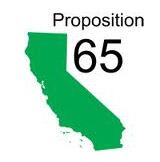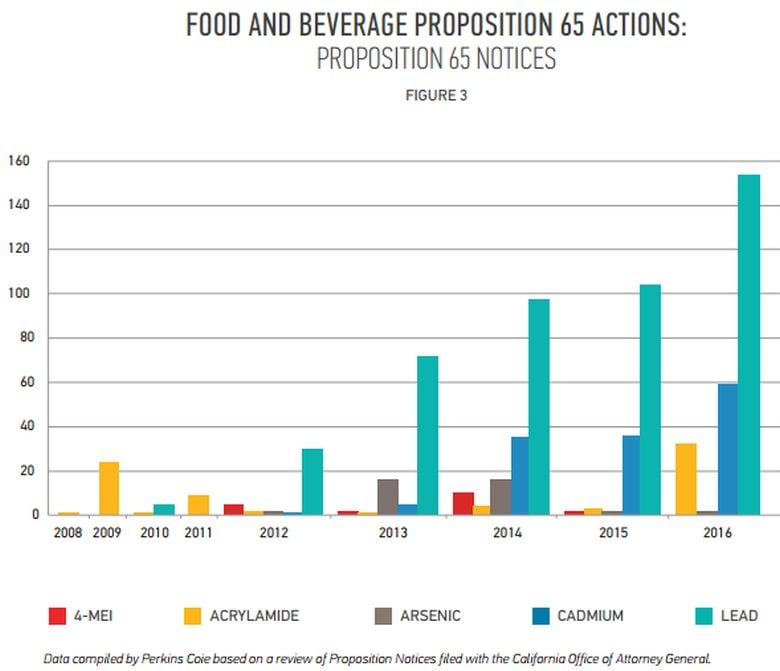Historically, most lawsuits have been filed for failure to provide Prop 65 warnings, whereas in future (post new rules that came into effect August 30), we can also expect lawsuits against firms providing inadequate warnings labels, as companies grapple with multiple new labeling options, particularly on websites, said Kristine Kruger, a San Francisco-based attorney with Perkins Coie’s food and beverage team.
“We think this will open up entirely new challenges wherein the contents of a warning are challenged as being inadequate and this is likely to make compliance more difficult and will almost certainly result in increased enforcement activity. In the past, the warning was generic, so no one was suing over the wording, just over a failure to warn.”
Many other manufacturers may simply be sued because they are not aware that the law has changed and haven’t updated warning labels, predicted Morrison & Foerster partner Michael Steel.
The new requirements
Under the new rules (see box below), which apply to products manufactured on or after August 30, 2018, manufacturers can provide short form generic warnings on product labels in a type size “no smaller than the largest type size used for other consumer information on the product,” with a minimum of 6-point type.
They can also provide long-form warnings specifying which Prop 65 chemicals may be in the product, although realistically most companies will choose the shorter warnings, predicted Steel.
Manufacturers reluctant to put warnings on individual products can provide warning materials to ‘authorized agents’ at retail customers to appear on shelf labels/signs or websites, but must also receive written or electronic confirmation acknowledging receipt, vital should a legal challenge be made.
However, given the practical challenges this raises (retailers “hate” Prop 65 signs, which are required to stay next to the specific product to which the warnings refer, says Steel), he is advising retailers receiving such requests to tell manufacturers to label their own products: “If it needs a warning, you put a label on it.”
The same applies to distributors, he added: “I’ve seen manufacturers send a bunch of signs to distributors with a note to send them onto all their retail partners, which is just not going to work. My response is they should get back to the manufacturer and say we’re not in the business of distributing signs. But people are very confused.”
"It used to be that two thirds of Prop 65 plaintiffs were just in it for the money, today it’s probably 95%..."
Michael Steel, partner, Morrison & Foerster
Legalized blackmail?
Despite its laudable aims, Prop 65 has proved controversial given that the vast majority of firms sued over alleged violations opt to settle - even if they are supremely confident in the safety of their products - because the burden of proof is on defendants to prove there is ‘no significant risk’ or ‘no observable effect’ from detectible levels of Prop 65 chemicals, added Steel.
Even if manufacturers can prove they are under Prop 65 safe harbor levels (which have been set for many Prop 65 substances) or that there are truly microscopic levels of contaminants in the product, the costs associated with defending yourself (hiring a toxicology expert, legal fees etc) will almost certainly exceed whatever amount plaintiffs demand in settlement, prompting some lawyers to argue that Prop 65 has turned into a form of “legalized blackmail”.
Said Steel: “If you are challenged by good guys that genuinely care about the environment and you can prove there’s nothing there or you’re under the threshold, and that the case basically doesn’t have merit, they may walk away before filing a suit [plaintiffs must provide 60-days of notice before suing].
"But most plaintiffs today will sue anyway, because they don’t care, they know that even if you can find renowned experts who will say that your products are safe, they know that’s going to cost you a ton of money and that it’s not worth it.
“It used to be that two thirds of plaintiffs were just in it for the money, today it’s probably 95%, and a lot of cases are being settled privately before a complaint is even [formally] filed [although this is risky for the defendant as it doesn’t stop other litigants suing over the same issue].”
Handful of litigants bringing vast majority of Prop 65 cases
According to the office of the California attorney general, the most prolific litigants in 2017 (when settlements topped $25.8m) included The Chanler Group Plaintiffs (which secured 147 Prop-65-related settlements in 2017), Brodsky & Smith Plaintiffs (115 settlements), Consumer Advocacy Group (30), Ecological Alliance LLC (72), and The Environmental Research Center (60), which have made millions out of Prop 65 suits in recent years.
While some Prop 65 cases have real merit, many appear to be blatant revenue-generating exercises for the plaintiffs’ lawyers, claimed Kruger. “Prop 65 remains very controversial as it’s generated so many bounty hunter lawsuits. Last year 76% of settlement money went to attorneys’ fees, so there’s a huge incentive for attorneys to get into this business.”
Meanwhile, the number of plaintiffs deciding to focus on Prop 65 litigation is also increasing, added Steel, given how easy it is to file a case and the fact that the burden of proof is on manufacturers to show their products are safe, not on the plaintiff to prove they are not.
“You don’t even have to leave your living room. You just go online and start shopping, then spend a couple of hundred bucks on a lab test and you could get $20,000 out of a company.”
Who benefits?
But will the new regulations benefit consumers? It’s hard to see how, said Steel: “It probably started with good intentions, but it was naïve. It won’t make the warnings any more meaningful to consumers.”
- The OLD Proposition 65 warning stated: ‘WARNING: This product contains a chemical known to the State of California to cause cancer.’
- The NEW long form warning looks like this: ‘⚠ WARNING: This product can expose you to lead, which is known to the State of California to cause cancer. For more information go to www.P65Warnings.ca.gov.
- OR this: WARNING: This product can expose you to chemicals including lead, which is known to the State of California to cause cancer, and Molinate which is known to the State of California to cause birth defects or other reproductive harm. For more information go to www.P65Warnings.ca.gov.
- The NEW short form warning could look like this: ‘⚠ WARNING: Cancer. www.P65Warnings.ca.gov’
- OR this: ⚠ WARNING: Reproductive Harm - www.P65Warnings.ca.gov
- OR this: ⚠ WARNING: Cancer and Reproductive Harm - www.P65Warnings.ca.gov

OEHHA has issued guidance on how internet retailers can comply with the new regulations. Specifically, website warnings must either be:
(1) placed on the product’s display page
(2) given via hyperlink using the word WARNING placed on the product display page, or
(3) displayed, with a tie to the product for which the warning is being given, to the consumer before the purchase is completed (such as having the warning appear when the shopper enters a California zip code at the checkout).
A warning does not satisfy Prop 65’s requirements if the purchaser is required to search for it.

Prop 65 and acrylamide
The California Court of Appeal recently held that a plaintiff’s suit seeking to require Prop 65 acrylamide based cancer warnings on popular breakfast cereals was pre-empted by federal nutrition policies aimed at encouraging Americans to consume more whole grains and by FDA letters stating that any warnings should be deferred given the uncertain science on the risks to humans of acrylamide in food. “This conflict pre-emption ruling should help convince courts in other contexts that state warning requirements should defer to more carefully articulated federal policies,” say attorneys at Perkins Coie.
In an August 29 statement, FDA commissioner Dr Scott Gottlieb also noted that “requiring a cancer warning on coffee, based on the presence of acrylamide, would be more likely to mislead consumers than to inform them,” and welcomed the fact that OEHHA says it will exempt coffee from Prop 65 cancer warnings.


